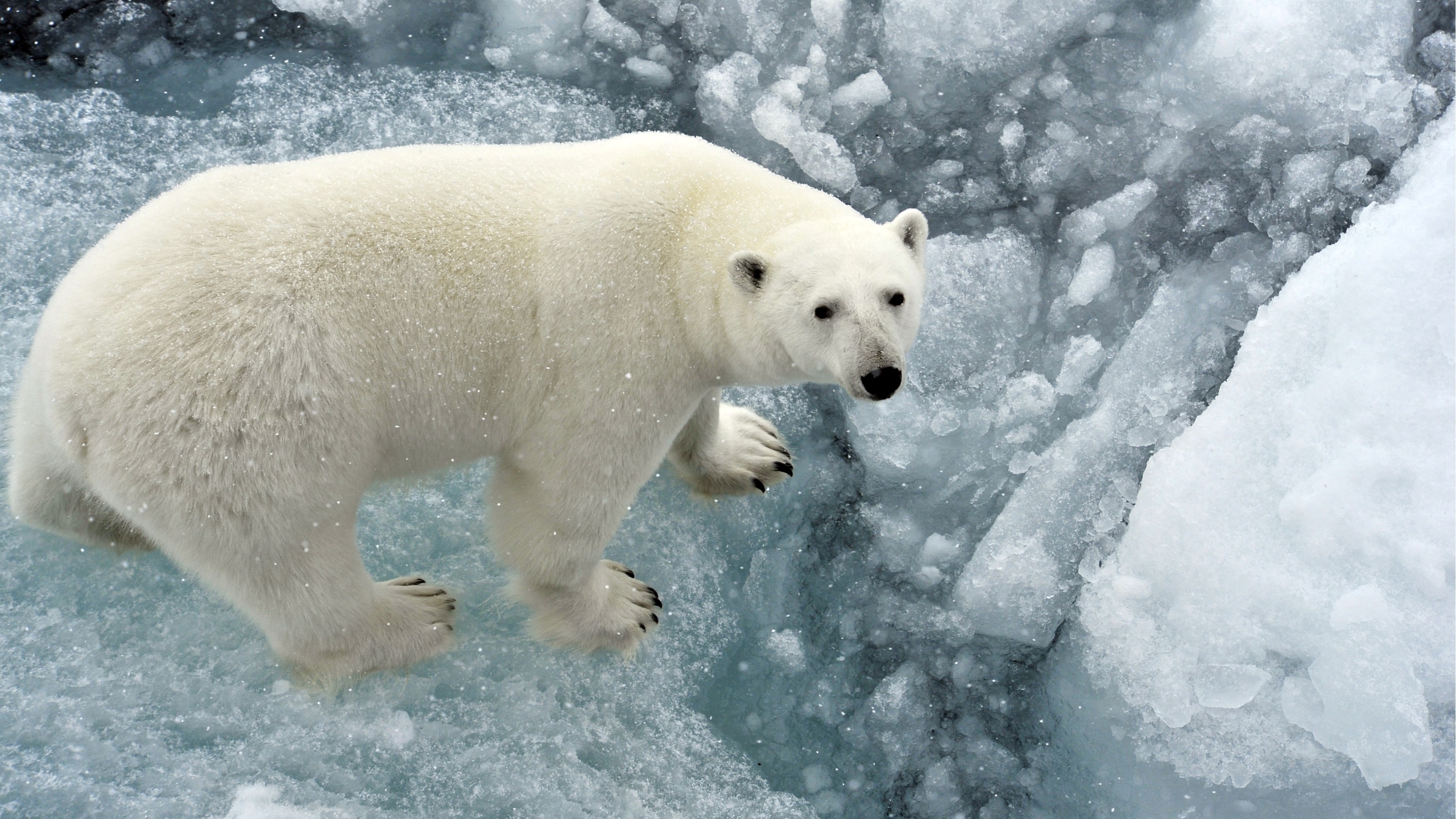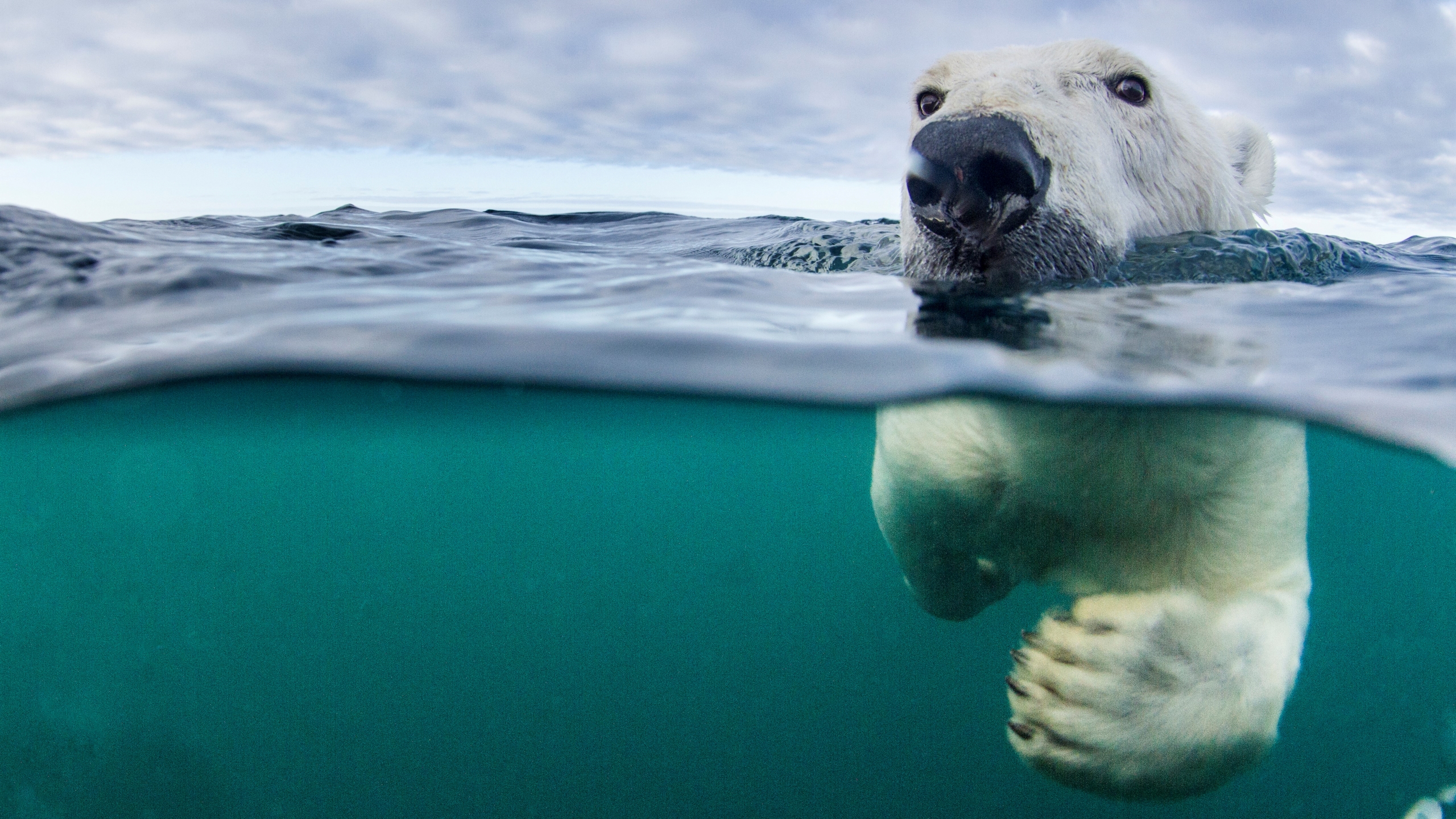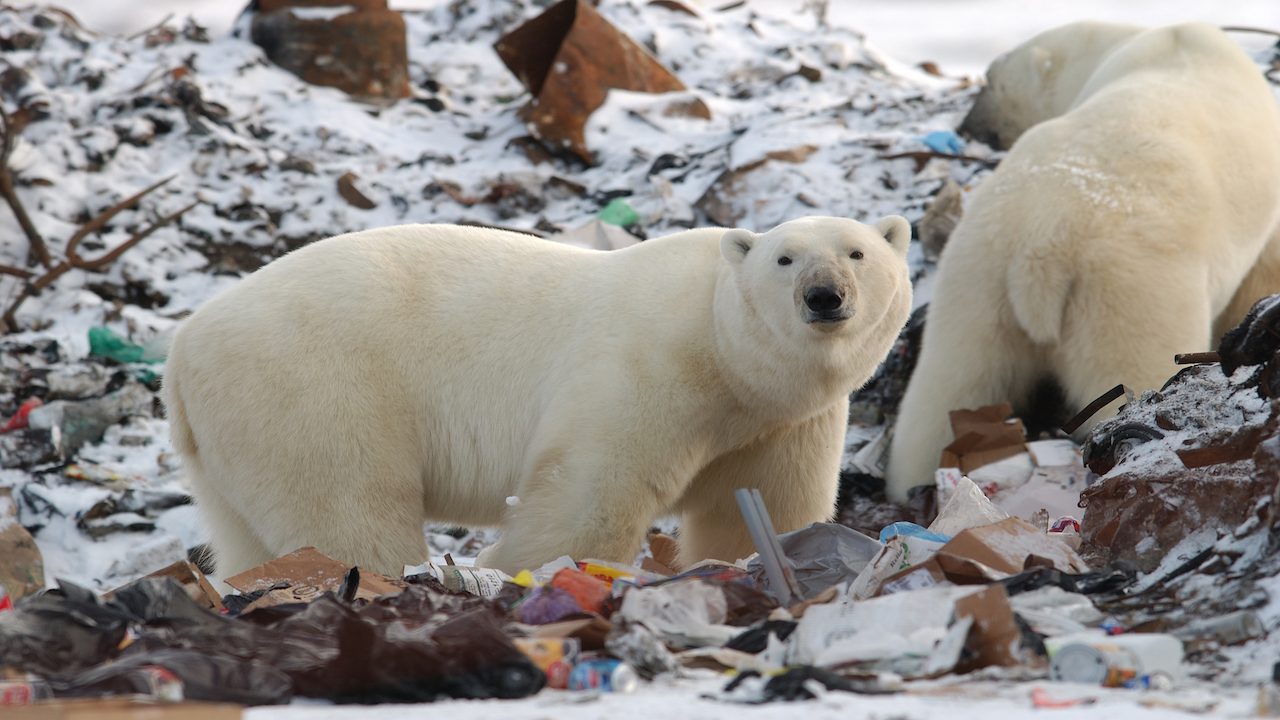A Polar Bear's Size How Old Is a Baby Polar Bear
Polar bears: The largest state carnivores

Polar bears (Ursus maritimus) are the largest conduct species and the biggest country carnivores in the earth. The enormous bears live in the Arctic, where they prowl the icy expanse searching for seals, their preferred prey.
Polar bears likely evolved within the final 500,000 years when a population of brown bears traveled n into the Arctic during a warm period and became isolated. When temperatures dropped again, the bears were forced to adapt to the colder surroundings, co-ordinate to Aarhus Academy's Chill Research Centre in Denmark.
Polar bears take many adaptations for life in the frigid Arctic, including dumbo fur and a thick layer of fatty to proceed them warm, as well as small bumps under their paws to finish them from slipping on the ice, according to Polar Bears International. They are excellent swimmers, and their scientific name, Ursus maritimus, translates to "bounding main bear," according to the San Diego Zoo. Polar bears depend heavily on the ocean environs and are the only bears to exist considered marine mammals.
Related: Polar behave photos: Stunning shots capture Earth'due south icons of climatic change
Size & advent
Polar bears are usually 3.five to 5 feet (ane to 1.5 meters) tall at the shoulder on all fours, but an developed male may achieve more than than 10 anxiety (3 chiliad) when standing on its hind legs, according to Polar Bears International. In 1960, a polar bear that was killed in Alaska stood 12 anxiety (3.7 m) tall on its hind legs, co-ordinate to the National Wildlife Federation.
Male person polar bears usually counterbalance betwixt 770 pounds and more than than 1,300 pounds (350 to 600 kilograms). The 12-foot-tall Alaskan acquit shot in 1960 is the heaviest recorded deport and weighed 2,210 pounds (one,000 kg). Females weigh half as much as their male counterparts, at 330 to 650 pounds (150 to 295 kg), according to Polar Bears International.
KEY FACTS
Size: 3.5 to 5 feet (one.5 g) tall at the shoulder (all fours)
Life bridge: xv to xviii years
Conservation status: Vulnerable
Polar carry fur appears to be white merely it's actually transparent; the white appearance is due to visible light handful and reflecting back off clear, hollow strands of hair, according to Polar Bears International. Their white appearance enables the bears to blend in with their snow-covered, icy environment. Polar bears tin besides announced yellowish or even brown and greyness, depending on the season and light weather condition. Polar bear skin is black and absorbs the rut of the sun, which helps continue the bears warm.
Polar bears vs. Kodiak bears
Polar bears are the biggest comport species, but Kodiak bears, a subspecies, or blazon of brown behave, can grow to well-nigh the same size as some polar bears. Kodiak bears live on islands in the Kodiak Archipelago off southern Alaska, where they have been isolated from other brown bears for about 12,000 years, co-ordinate to the Alaska Department of Fish and Game. These chocolate-brown bears can stand up over 10 feet (3m) tall on their hind legs and weigh up to 1,500 pounds (680 kg), according to the Alaska Department of Fish and Game.
Some sources, such equally the Alaska Department of Fish and Game, claim that Kodiak bears are the largest bears on Earth. The defoliation is partly due to the style that "largest" is defined, because the answer varies depending on whether bears are measured past length, weight, or by the largest private ever recorded, according to the Library of Congress in Washington, D.C. Polar bears are heavier and taller on average, but individual Kodiak bears may be larger than boilerplate-size polar bears.
Where exercise polar bears alive?
Polar bears alive on the ice-covered waters of the Arctic and countries around the Arctic Circle, including Canada, Alaska in the U.S., Greenland (part of Denmark), Norway, Russia and occasionally Iceland, according to the International Wedlock for Conservation of Nature (IUCN). They are not plant in Antarctica, where penguins live.
Some polar bears stay on permanently frozen bounding main ice in the Chill Basin, merely near live on the annual bounding main ice that forms around the Arctic Bowl. This annual ocean ice melts in the summer, so polar bears are forced to spend several months on land while they wait for it to freeze over again, according to the IUCN.

Polar bears swim betwixt body of water ice and the shore, hunting downward prey, searching for mates, or just cooling off. They paddle through the water with their big forepart paws and utilise their back legs as rudders, according to Bounding main World. They also accept webbing between their toes, similar to ducks' anxiety, which helps them swim.
Polar bears have been recorded pond for well-nigh 10 days at a time and traveling up to 427 miles (687 kilometers) in a single swim without stopping to residuum, Live Science previously reported. Long swims like this put polar bears at adventure of drowning, just they may be forced to undertake such great journeys more oft as warming temperatures associated with climate change melt sea ice in the Arctic.
Related: Sweating the details: Polar comport hits the treadmill for science
What do polar bears eat?
Polar bears are the most carnivorous bear species and almost exclusively eat meat. Their primary prey are ringed seals (Pusa hispida), according to the National Wildlife Federation. Polar bears will sit by a seal breathing hole waiting for a seal to popular upwardly then they can catch it. The bears will also sniff out seal dens, so crash through the roof and impale the seals inside.
If polar bears have a plentiful supply of seals and are in good wellness, they'll but consume the seal's blubber, according to Polar Bears International. This is the highest calorie repast available to polar bears and helps them build upwards fatty reserves and stay healthy between feedings. Polar bears tin consume 4.4 pounds (two kg) of fat each mean solar day, according to the World Wild animals Fund (WWF).
Polar bears volition besides hunt walruses, sea birds, fish and small-scale mammals such as rodents; scavenge on whale carcasses and other expressionless animals; and eat small amounts of vegetation, according to the University of Michigan'south Animal Diversity Web (ADW). However, these are alternative food sources when seals aren't plentiful; seals are crucial to sustaining a polar bear population. Polar bears are peak of the food chain and have no natural predators other than humans.
Related: Polar bears now eat dolphins, thank you to global warming
Life in the common cold

Polar bears are lonely except for when a mother is raising her cubs. However, unrelated bears will occasionally be seen together, such as when they share a large whale carcass or garbage dump, or when they are waiting on land for sea water ice to re-class, according to Ocean World. They practice not defend territories, but polar bears may occasionally fight over a carcass, and males may fight over a female during the breeding season, between March and June.
Male polar bears notice females by following their scent, and the pair may spend a week or more than with each other. Afterward mating, fertilized eggs don't enter the female's uterus straight away, and this process is delayed until usually September or November, co-ordinate to the San Diego Zoo. Polar bears have a gestation flow of upwardly to about seven months including this delayed implantation. Meaning females volition dig a cave in a snowbank to requite birth in; called a maternity den. Polar bears do non hibernate in winter, unlike most chocolate-brown bears and black bears, and will go on to hunt unless the weather is extremely harsh.
POLAR BEAR TAXONOMY
Kingdom: Animalia
Phylum: Chordata
Grade: Mammalia
Social club: Carnivora
Family: Ursidae
Genus & species: Ursus maritimus
Source: ITIS
A female polar acquit gives birth in her den, typically to twins in Dec or January. Newborn polar bear cubs usually weigh but ane.3 pounds (0.half-dozen kg), according to the San Diego Zoo. The cubs grow chop-chop on their mother's milk and will start exploring outside their den past jump, although they don't travel far for the beginning 12 days or more than and still sleep inside the den at night, according to Sea World. Polar bear cubs stay with their mother for up to iii years learning how to survive. Wild polar bears commonly live for fifteen to 18 years simply tin can survive into their 30s, according to Polar Bears International. A captive polar conduct called Debby lived to exist 42 years old in Assiniboine Park Zoo in Canada. She was believed to be the globe's oldest polar bear when she died in 2008, co-ordinate to Reuters.
Related: Polar bear trunk cam shows predator's POV
Are polar bears dangerous to humans?
Polar bears rarely attack humans. A 2017 report published in the periodical Wildlife Society Bulletin cataloged 73 confirmed polar deport attacks between 1870 and 2014, including 20 fatalities. The researchers found that nutritionally stressed male bears were near likely to assault humans and that virtually attacks were predatory, meaning the comport was killing for food. Polar bear attacks increased over the written report menstruation, which is probable due to changes in their environs.
"The danger is the proximity to people, coupled with an increasing number of polar bears in poor body condition spending more time on shore. Both people and bears are trying to adapt to rapid changes on the ground and at sea," Geoff York, study co-writer and senior manager of conservation at Polar Bears International, said in a statement at the time. As sea ice declines and moves further from the shore, more polar bears spend longer periods on land, such every bit in Hudson Bay in northeastern Canada.
"Bears are at present having to make a choice equally the ice melts each twelvemonth: Practise they stay on the water ice and retreat with it into deep Chill waters or do they jump, come to shore, and take their chances on land?" York said. "Those who come up aground may come into conflict with human being communities or activities. And as they get more desperate for nutrient, they may well accept higher risks."
Related: 52 polar bears 'invade' a Russian town to eat garbage instead of starve to death

Are polar bears endangered?
Polar bears are vulnerable to extinction, according to the IUCN Ruddy Listing of Threatened Species. Climate change poses the biggest threat to their long-term survival as increasing temperatures crusade the Arctic sea ice they depend on to shrink. They are also threatened by other man-related activities, such as oil and gas drilling in the Arctic, which increases the hazard of negative human being-bear interactions.
In that location are only well-nigh 26,000 polar bears living in the wild, according to the IUCN. All the same, estimating the number of polar bears is difficult because they live in such remote habitats at low densities, and information nigh their subpopulations is frequently poor or outdated. Polar bears are listed on the U.S. Endangered Species List as threatened and are protected nether the Marine Mammal Protection Act.
Inuit and Indigenous people nonetheless hunt polar bears for food and clothing equally part of long-held cultural traditions, merely this hunting is carefully regulated. The Inuit people have long believed that polar bears, which they call "Nanuq," are wise, powerful and almost human, co-ordinate to Polar Bears International.
Related: 'Pizzly' bear hybrids are spreading across the Arctic thank you to climatic change
Boosted resources
- The U.s. Geological Survey carries out long-term research on polar bears
- Polar Bears International has more information most polar bears and conservation efforts to save them.
- Children'southward Book: "The Polar Bear" (Enchanted King of beasts Books, 2016).
This article was originally written by Live Scientific discipline correspondent Alina Bradford and has since been updated.
Source: https://www.livescience.com/27436-polar-bear-facts.html

Belum ada Komentar untuk "A Polar Bear's Size How Old Is a Baby Polar Bear"
Posting Komentar